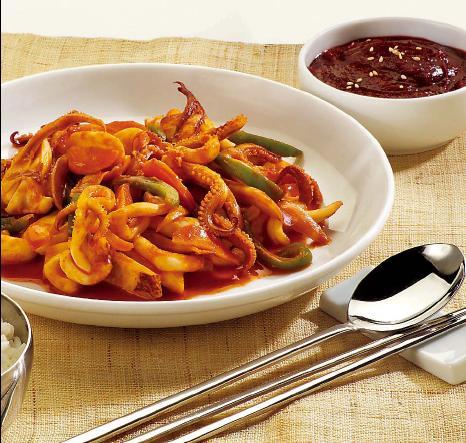[Savor Korea (24)]
The global market has its fair share of hot sauces.
There is the standard Tabasco, capped in a narrow-necked bottle and ideal for sprinkling over most anything that needs a dusting of slow-burning heat. Then there is the newcomer, sriracha -- in its authentic Thai or revamped international form. Salsa, of course, is another classic rendition of sauced-up chili peppers.
Now gochujang seeks to claim some hot sauce turf by going mainstream.
Food company CJ CheilJedang Corporation spearheaded the movement when it launched its sweet and spicy sauce in January. Industry rival Daesang is not far behind with its own take on the chili paste.
Then there are companies like the Singapore-based Asian Home Gourmet.
The Pan-Asian food business jumped into the game about two years ago when it developed a Korean line that included gochujang.
For now, the overseas market for the traditional condiment caters primarily to overseas Korean or Asian communities.
Both CJ’s Haechandle (their traditional version of gochujang) and Daesang’s Chungjungwon Sunchang Gochujang’s biggest international clientele are Korean expats.
That may change.
With CJ’s new sauce out on the shelves of around 700 stores in America, the playing field has expanded drastically, giving rise to the question: Can gochujang become the next big hot sauce?
Sauce or Paste?
Both CJ and Daesang, two major producers of gochujang, seem to think that the secret to satisfying the global palate is to transform it into a sauce. Asian Home Gourmet, on the other hand, decided to market their product as a paste.
With over 27 years of industry experience and seven cuisine lines in over 8,000 major stores throughout 41 countries, Asian Home Gourmet could have a significant edge over CJ and Daesang.
Then again, while CJ is sending its sauce to major supermarkets, Asian Home Gourmet’s gochujang, says deputy general manager Justin Lam, “is mostly an Asian market product” in America.
“Korean, to be frank, is still, relatively speaking, an exotic cuisine,” said Lam. “In Australia, 82 percent of consumers would have had Chinese food once in the last year. 50 percent would have had Thai. 25 percent would have had Korean.”
“This (gochujang) is probably the most difficult product to articulate,” Lam elaborated. “I think the specific difficulty is that it’s not something that people would recognize from a restaurant menu. That’s number one. Number two is that it’s almost too versatile and the problem with products that are too versatile is that people don’t know what to do with them.”
“With this particular product you’re almost selling a cooking culture,” he said. “This is and isn’t a stir-fry paste. It is and isn’t a marinade and it is and it isn’t a seasoning.”
That is why Asian Home Gourmet called their product a “Korean Hot Pepper Stir Fry,” because a marinade “would have been too overpowering for most people.” A stir-fry, on the other hand, was seen as a “reasonable compromise.”
Furthermore, selling it in a form that translates into a specific dish makes it easy to use.
The “pack formula” paste form, says Lam, has “been around for probably 20 years.” The small portion, one packet serves around two to four, is ideal for Western consumers who want to enjoy the perk of Asian cuisine but not on a day-to-day basis.
CJ, in contrast, wants customers to use their sauce -- which is being sold under the company’s U.S. brand Annie Chun -- often and on almost everything.
Souped-up in a nifty container that resembles a ketchup bottle, Annie Chun’s Go-Chu-Jang, says CJ Global Food Division business manager Chung Ha-myung, works well as a dipping sauce for chicken tenders and French fries.
The discovery that their new sauce could be paired with fried food stemmed from a series of taste and home usage tests conducted on non-Korean participants.
But why did CJ change the traditional paste into a sauce?
“The sauce culture is really developed in America,” said Chung.
“If an American opens up this container of paste, they will not know what to do with it, how to take a spoon to it,” he explained. “That is why we need a sauce.”
The result is a “crossover” liquid condiment that is nutty, sweet and not too spicy, a product that targets the average American consumer.
“It will be positioned as a new hot sauce,” said Chung. “Gochujang is the next hot salsa, the next generation salsa.”
Domestic gochujang rival Daesang is close behind.
“We are pushing forward with the development of a sauce-type gochujang that can go with any dish and that can work in any country,” Daesang Corp. Overseas Business Division director Sung Soo-Choi wrote in an e-mail interview.
Sung listed Tabasco sauce as a quintessential model of the type of product they are going for.
The competition is heating up.
But just how hot is too hot?
Handling the heat
Both CJ and Asian Home Gourmet seem to think that Western consumers are looking for a flame not a fire.
Annie Chun’s Go-Chu-Jang will barely tickle the tongue of a Korean consumer who is more accustomed to the heat of the traditional stuff. Asian Home Gourmet’s product, says Lam, “would probably have a bit of a zing” for a typical Western consumer.
Then again, there is still a market for the extra hot stuff. After all, chili lovers reside in every nation.
There is also a need -- as evidenced by consumers who check menus for the telltale picture of a chili pepper next to a spicy dish -- for a barometer of the heat level of the product or dish they are purchasing.
Enter the gochujang “hotness” level standardization project.
The project, through the joint efforts of the Ministry for Food, Agriculture, Forestry and Fisheries, the Korea Food Research Institute and gochujang manufacturers, proposes a standard heat measurement for the spiciness of gochujang.
Foregoing the already well-known Scoville scale -- a spiciness barometer created by an American chemist in 1912 -- the government-run project will introduce a new form of measurement: the Gochujang Hot-Taste Unit.
“The sensation and taste of heat from a hot sauce and that from gochujang must be separately classified,” Korea Food Research Institute Food Standards Team Leader Jeong Seong-weon explained why they opted for the GHU.
A GHU-based five level scale -- mildly, slightly, medium, very and extremely hot -- is slated to go into effect by the end of April.
Both CJ and Daesang took part in this project and plan on using the new scale for their gochujang exports.
While this may be effective for domestic consumers, will it translate well abroad?
“Rather than using a scale, my preferred approach is to actually do a bit of research and then use consumer friendly language to sort of describe it,” said Lam.
“Rather than make it look like something that’s very scientific, very complicated, I think simple language like mild, hot, very hot actually goes out a lot better,” he added.
Lam also warned against the dangers of getting too specific.
“For example, we sell to continental Europe,” he explained. “They have a much lower tolerance to chili than most people, so if you sort of get really complicated you almost need a different scale for a different market.”
In other words, what one consumer may think is slightly hot another might think is very hot; hence the simpler three level system, which gives the product a wider berth for what it defines as spicy.
Such a revision to the grading system would not affect the GHU. All it would require is the elimination of two categories. Then again, the GHU is based on the palates of Koreans.
“The taste tests were conducted on Koreans and the results of the tests were fully instituted,” said Korea Food Research Institute’s Jeong in an e-mail interview.
If that is the case, then is the GHU suitable for the international market?
Only time will tell.
The Pitch
Heat scale issues aside, the true challenge of taking gochujang mainstream seems to lie in how it is marketed.
CJ is going at it from a variety of angles.
Recipes featuring a diverse array of fusion-style dishes like spicy meatloaf or a gochujang and soju Bloody Mary alongside more traditional fare like bulgogi and bibimbap are listed on the sauce’s website (mygochujang.com) and are attached as a booklet to their product. A burger contest invites the adventurous to try their hand at incorporating the sauce into the classic American dish.
Cross-couponing with other products already sold in the market and advertorials placed in chef-oriented publications are also part of the company’s promotional campaign, said Chung.
The whole angle seems to be about finding a way to integrate the condiment into the fabric of the American market.
In contrast, Asian Home Gourmet seems to be taking a more organic approach.
“The idea is that if we have a big enough range and we have consumers who trust the brand, then they would be prepared to explore,” said Lam.
In other words, a consumer who has enjoyed other Asian Home Gourmet products might be inclined to give their gochujang a go.
For now, the future of gochujang looks bright.
Both CJ and Daesang reported increases in the sales of their gochujang exports.
In 2007, CJ’s Haechandle nabbed export sales of $7 million, in 2008 figures went up to $9 million. Last year export sales broke through the $10 million mark.
Daesang’s gochujang, according to Overseas Business Division Director Choi, posted export sales of around 10 billion won ($8.97 million) in 2009.
“Export sales are continuously increasing each year and sales are expanding beyond regions such as America, China and Japan where there are a lot of overseas Koreans,” said Choi. “Especially in China and Japan, our product is sold through local distribution channels.
“More and more locals are using the product,” Choi added, fostering hope that amidst all these efforts towards the globalization of gochujang, overseas interest in the beloved Korean condiment is on the rise.
By Jean Oh (oh_jean@heraldcorp.com)
This is the 24th installment of a series that will delve into the current movement towards the globalization of Korean cuisine from a variety of perspectives. The series will explore hansik’s past and present, its global potential, and efforts that are being made to promote it to the world. – Ed. 





![[Weekender] How DDP emerged as an icon of Seoul](http://res.heraldm.com/phpwas/restmb_idxmake.php?idx=645&simg=/content/image/2024/04/25/20240425050915_0.jpg&u=)
